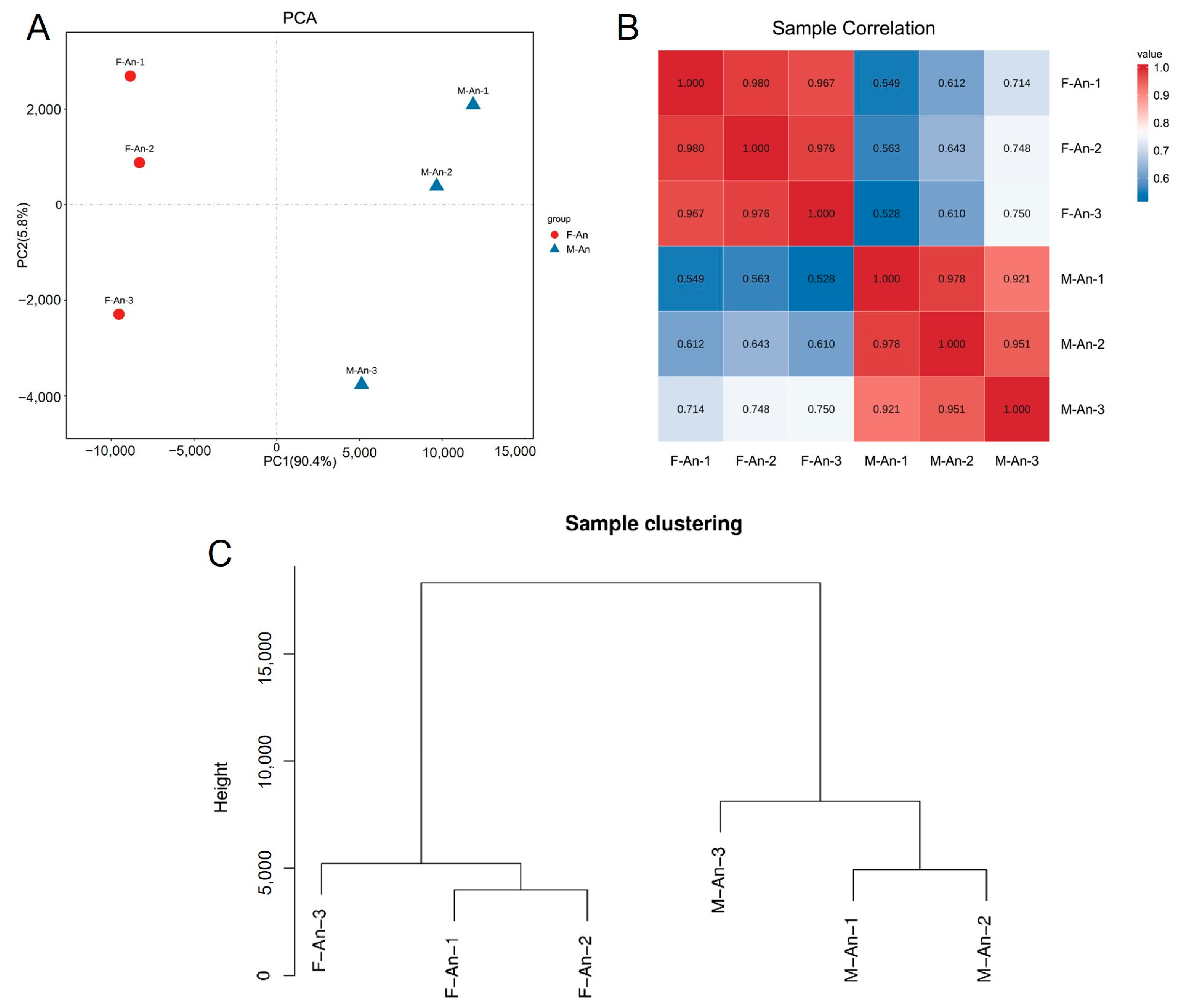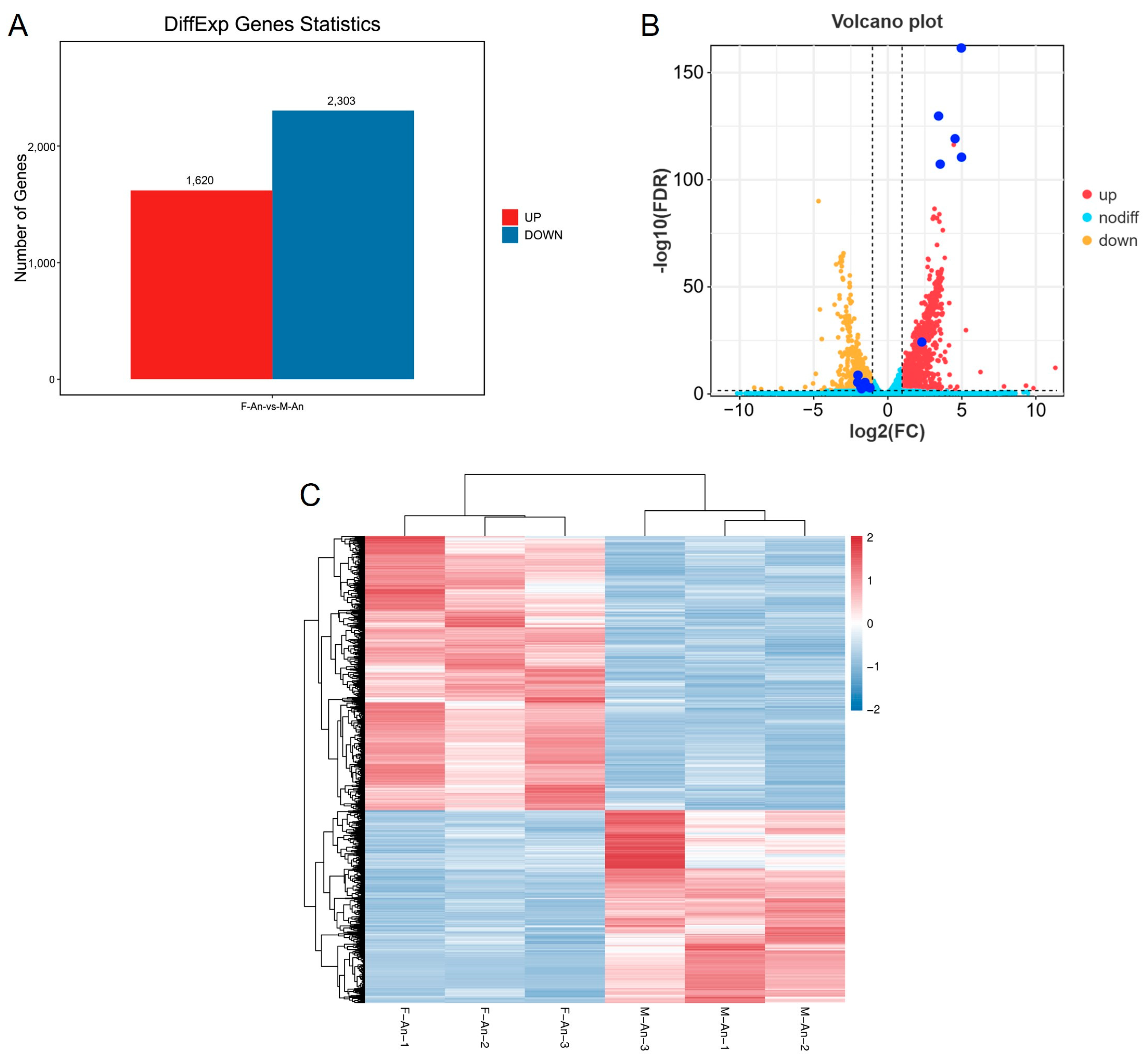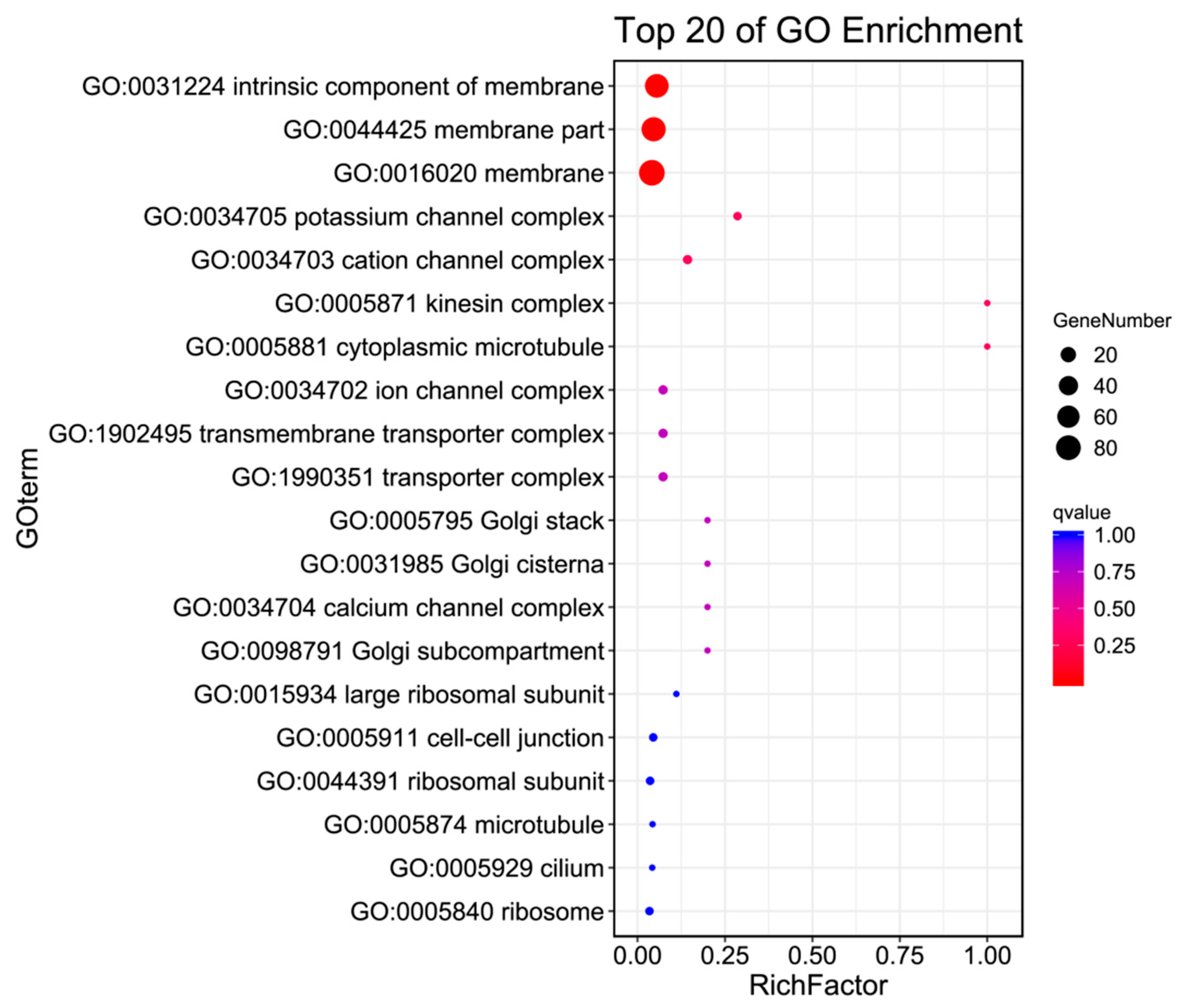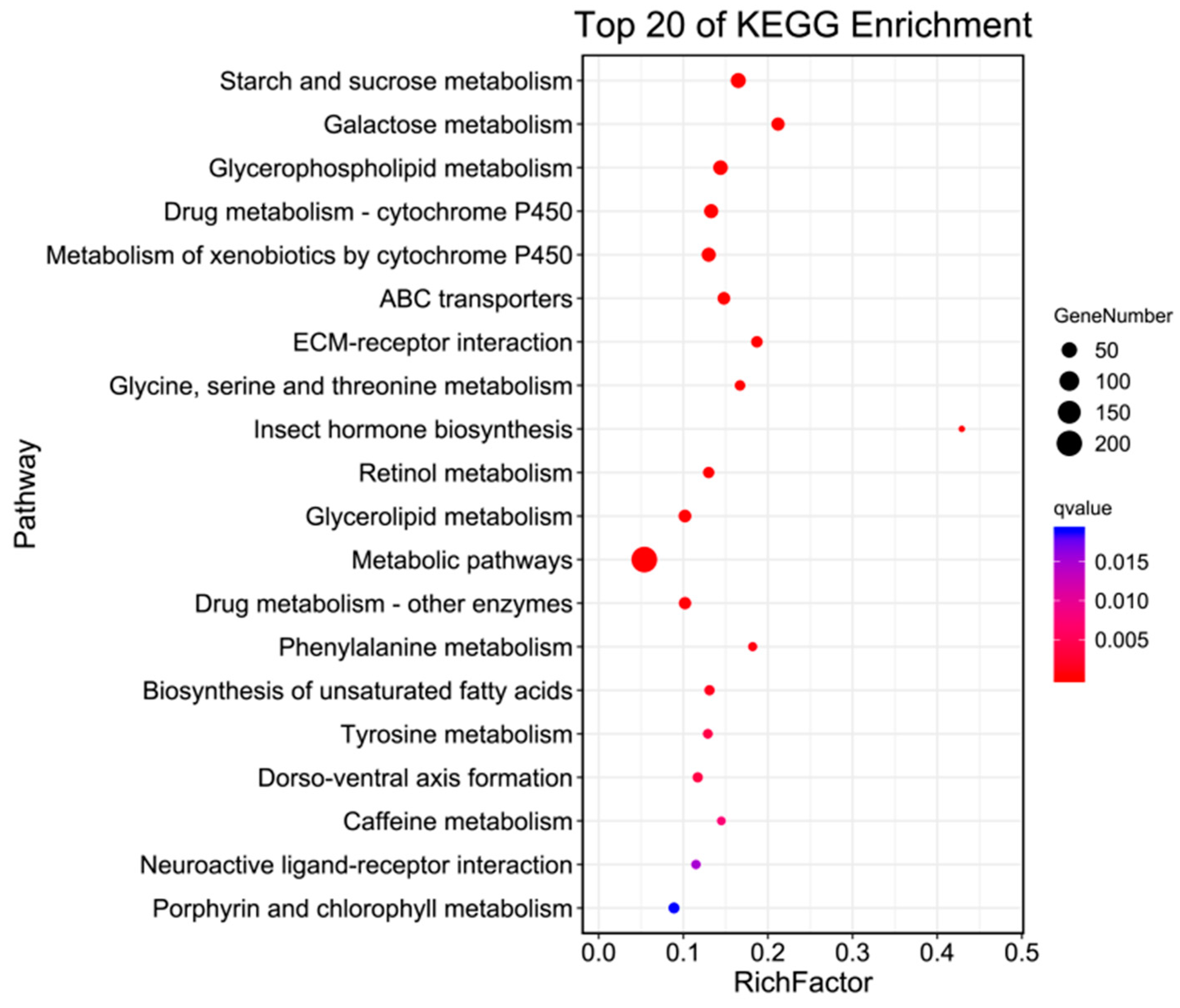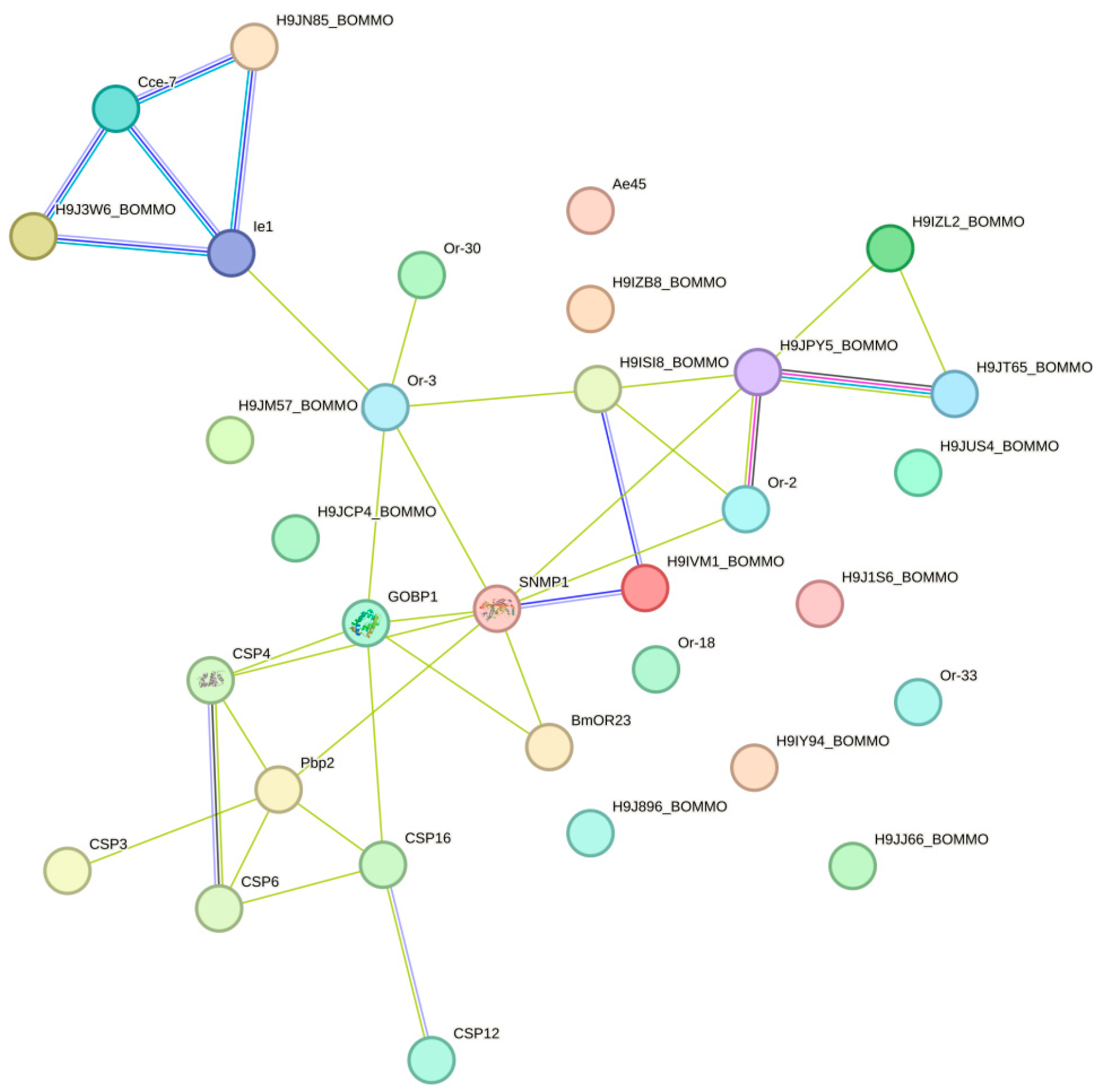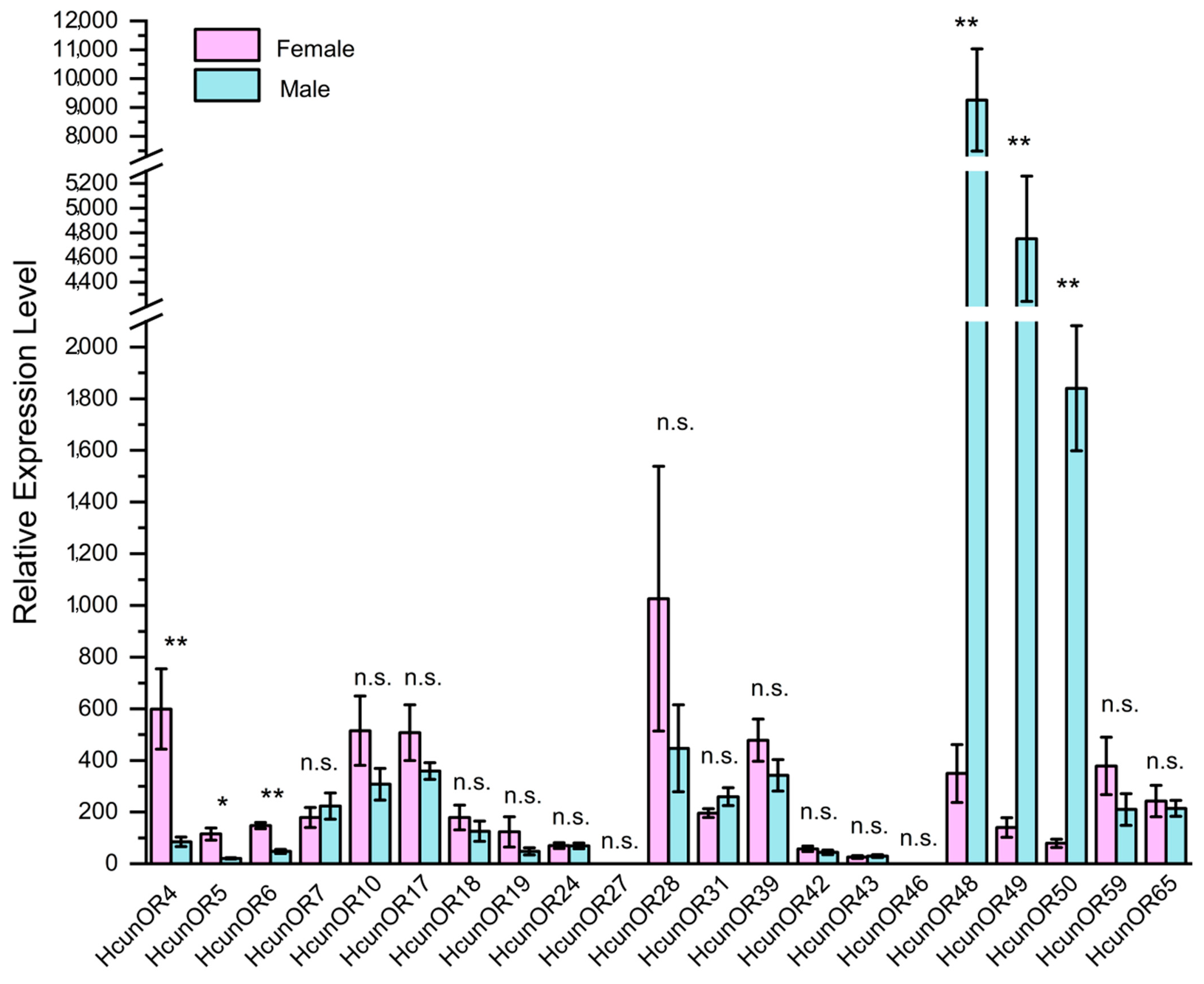1. Introduction
Insects rely on their olfactory senses to perceive various odors and chemical cues in the environment, enabling them to locate mates, find hosts, identify oviposition sites, and evade predators [
1,
2]. The olfactory sensing process of insects recognizing odor molecules and elicit behavioral responses involves two primary steps: (1) In the peripheral olfactory system, odor molecules enter the lymph through the pores of the antennae and are transported by olfactory-related proteins to the dendritic membranes of olfactory neurons, subsequently activating membrane-bound olfactory-related proteins; (2) olfactory neurons convert the chemical signals into electrical signals, transmitting them to the central nervous system, eliciting behavioral responses in insects [
3,
4]. Chemosensory proteins (CSPs) and odorant binding proteins (OBPs) are involved in dissolving odor molecules and transporting them to the vicinity of olfactory neuron dendritic membranes. Odorant receptors (ORs) and ionotropic receptors (IRs) on the dendritic membranes recognize odor molecules and transmit signals to the central nervous system. After the olfactory response, odorant-degrading enzymes (ODEs) and sensory neuron membrane proteins (SNMPs) degrade odor molecules, preventing continuous stimulation of odor receptors that could damage the insect’s nervous system [
5]. The insect antennal transcriptome serves as an important foundation for studying the function of olfactory proteins. In recent years, with the development of high-throughput sequencing technologies, an increasing number of insect antennal transcriptomes have been reported [
6,
7].
Hyphantria cunea is a highly polyphagous pest that can feed on a wide range of host plants, including almost all forest trees and even crops, except for some hardwood and evergreen coniferous trees [
8].
H. cunea has a large feeding capacity, with larvae exhibiting the ability to withstand starvation and strong adaptability. In addition,
H. cunea has a broad dispersal range and can be transmitted through multiple pathways, causing severe economic losses [
9]. The antennal transcriptome of
H. cunea was first reported in 2016, identifying olfactory-related proteins such as OBPs, CSPs, ORs, SNMPs, GRs, and IRs [
10]. In addition, they performed semi-quantitative and relative quantitative analysis of the expression levels of 27 OBPs and 17 CSPs in different tissues between the two sexes, but sex-biased expression levels of odorant receptor genes were not identified. Since the publication of the antennal transcriptome of
H. cunea in 2016, only a few studies have been published on the function characterization of general odorant receptors and sex pheromone-binding proteins in
H. cunea [
11,
12,
13]. However, the identification of odorant receptors for recognizing the sex pheromones of
H. cunea has not been reported. This suggests that there may be difficulties in the identification of sex pheromone receptors in
H. cunea. The sex pheromones of
H. cunea belong to type II moth sex pheromones, which are relatively rare [
14]. Thus, the odorant receptors for recognizing sex pheromones of
H. cunea may have low identity with the odorant receptors that recognize the more common type I moth sex pheromones [
15,
16]. Therefore, it was hypothesized that the sex pheromone receptors of
H. cunea may not belong to the traditional sex pheromone receptor evolutionary branch. Analyzing the sex-biased expression of the antennal transcriptome and the differential expression of odorant receptor genes of adult
H. cunea may help to screen for male-biased odorant receptor genes, which could provide a theoretical basis for the identification of the sex pheromone receptors in
H. cunea.
This study utilized second-generation transcriptome sequencing technology and fluorescent quantitative PCR technology to analyze the differences in transcription levels in the antennal tissues of H. cunea. A total of 221 olfactory-related genes were annotated, and in the differential analysis, 96 sex-specific genes were identified, including 13 ORs, 48 OBPs, 7 CSPs, 10 IRs, 10 SNMPs, 2 GRs, and 6 ODEs, indicating the presence of olfactory differences between male and female H. cunea. Both GO enrichment analysis and KEGG enrichment analysis were conducted, and the differentially expressed genes were mainly enriched in the subcategories of single-organism process (GO) and global and overview maps (KEGG). Fluorescent quantitative PCR technology was used to analyze the relative expression levels of 21 general odorant receptor genes obtained from the evolutionary analysis of the antennae of both male and female moths. HcunOR4 and HcunOR5 showed female-biased expression, while HcunOR48, HcunOR49, and HcunOR50 exhibited male-biased expression. These results were consistent with the transcriptome differential analysis, and the identification of genes with male-biased expression provides a foundation for predicting the sex pheromone receptors of H. cunea.
3. Discussion
H. cunea is a polyphagous pest that seriously threatens the growth of forest trees. Conducting chemical ecology research on the
H. cunea provides a theoretical basis for the scientific control of this pest. Although Zhang et al. published the transcriptome of
H. cunea antennae in 2016, their analysis was based on second-generation transcriptome sequencing of mixed samples from male and female antennae [
10]. As a result, the olfactory differences between male and female
H. cunea remain unclear.
As high-throughput sequencing technology and bioinformatics technology have developed, transcriptome sequencing has become an important means of research in insect chemical ecology, and it is the basis for studying the molecular mechanism of insect olfaction [
17,
18]. In data quality control, the percentage of bases with a sequencing quality value of Q20 or higher (clean bases) in the raw data was at least 97.64%, and the percentage of bases with a sequencing quality value of Q30 or higher was at least 93.07%. Both were greater than 89%, indicating that the sequencing quality was good and the base composition was balanced with high quality. In the sample correlation analysis, the PCA analysis showed that the biological replicates of the female and male groups were separately clustered on both sides of the PC1 axis, and the cluster analysis of the sample relationships showed that the female and male samples were separately clustered on two branches; the lowest Pearson correlation coefficient between the two samples within each group was 0.921, indicating that the differences between the biological replicates within each group were small and the reproducibility was good [
19].
Using GO enrichment analysis and KEGG enrichment analysis, the differentially expressed genes in the antennae of male and female
H. cunea were enriched in specific GO categories or KEGG pathways to elucidate the differences in metabolism and gene functional classification in the adult
H. cunea antennae. In the GO enrichment analysis, the differentially expressed genes in the antennae of male and female
H. cunea were mainly enriched in the biological process category. Among them, 353 genes were female-biased and 406 genes were male-biased, indicating that the antenna function of males may be more complex. This was consistent with the appearance that the male
H. cunea antennae were more complex and had more sensillum than the female antennae [
20]. In the KEGG metabolic pathway enrichment analysis, a total of 977 differentially expressed genes were enriched in the metabolism category, followed by 127 differentially expressed genes enriched in the environmental information processing category. In the environmental information processing category, the main metabolic pathway subcategory was signal transduction (69 differentially expressed genes), which was consistent with the function of the antennae in converting chemical signals such as odors into electrical signals transmitted to the central nervous system [
21,
22,
23]. This also indicated that there were differences in the function of the male and female antennae.
This study identified a total of 221 olfactory-related genes with complete open reading frames, including 26 odor receptor genes, 77 odorant binding protein genes, 46 chemosensory protein genes, 3 gustatory receptor genes, 40 ionotropic receptor genes, 11 neuronal membrane protein genes, and 18 odorant-degrading enzyme genes. In terms of total numbers, the quantity of olfactory-related genes identified in this study was similar to the results of antennal transcriptome annotation of other Lepidoptera insects, such as 238 candidate olfactory-related genes identified in the antennal transcriptome of the tea pest
Agriophara rhombata [
24], 142 genes identified in
Micromelalopha troglodyta [
25], and 217 genes identified in
Spodoptera litura [
26]. The number of odorant receptors was much lower than the 47 ORs identified by Zhang [
10], and we inferred that this might be related to the depth of the third-generation transcriptome sequencing. This study was based on the third-generation sequencing data of our project team supplemented with second-generation transcriptome data, so it is possible that the depth was not sufficient and that some fragments were lost. In addition, this study, in combination with the genome of
H. cunea, obtained 22 full-length odor receptor genes (about 400 amino acids), which was basically consistent with the approximately 400 amino acid odor receptor quantity (23 genes) reported by Zhang [
10]. This study only identified three gustatory receptor genes, and it was speculated that this was related to the fact that the antennae are not the main taste organs. Several reports have indicated that gustatory receptors are mainly expressed in the mouthparts of insects [
27]. There was a total of 96 differentially expressed olfactory-related genes, accounting for 43.24%, indicating differences in olfaction between male and female
H. cunea. Olfactory binding protein and neuronal membrane protein genes with significantly differential expression were both male-biased in expression. Males rely on airborne sex pheromones to locate females when seeking mates, and accurate and sensitive localization requires the timely deactivation of each odor molecule [
28]. Odor-degrading enzymes and sensory neuron membrane proteins both had the function of degrading odor molecules [
29], and the overexpression of these two proteins in males could explain the above phenomenon.
In the published transcriptome paper on the antennae of
H. cunea, Zhang used both semi-quantitative and relative quantitative methods to analyze the expression differences of 27 odorant-binding proteins and 17 chemosensory proteins between the two sexes. However, the expression differences of odorant receptors in the antennae of adult males and females were not analyzed. Therefore, this study used quantitative real-time PCR technology to verify the expression levels of the 21 annotated general odorant receptor genes in the two antennal tissues of males and females. Among them, six genes showed significant differential expression, with
HcunOR4,
HcunOR5, and
HcunOR6 preferentially expressed in females and
HcunOR48, Hcun
OR49, and
HcunOR50 preferentially expressed in males. Among the eight DGE OR genes in the transcriptome results, the quantitative results of
HcunOR4,
HcunOR5,
HcunOR48,
HcunOR49, and
HcunOR50 were consistent with the transcriptome differential analysis results. Three genes were inconsistent with the DGE results in the transcriptome. Although the transcriptome showed that
HcunOR6 was expressed at a higher level in females than in males, the difference was not significant, which might be related to the use of distinct biological replicates for transcriptome sequencing and quantitative analysis, sequencing errors, and variations in the methods used for differential significance analysis. Since the antennal transcriptome of
H. cunea was reported, the functions of sex pheromone receptors in
H. cunea have not been reported until now. The sex pheromones of
H. cunea belong to the relatively rare type II sex pheromones in moths, with low structural similarity to the common type I sex pheromones. On the basis of the principle of receptor-ligand similarity [
13,
30], it was inferred that the odorant receptors for recognizing the sex pheromone of
H. cunea might not belong to the traditional sex pheromone receptor evolutionary branch. The sex pheromones of
Ectropis grisescens and
E. obliqua were both type II pheromones of moths. The olfactory transcriptomes of these two moths were analyzed, and a possible type II pheromone receptor evolutionary branch was reported by analyzing the expression differences and evolutionary analysis of OR in the antennae of male and female adults, including four odorant receptors separately—EgriOR24, 31, 37, 44 and EoblOR24, 31, 37, 44—that were highly expressed in the antennae of males [
31,
32]. In this research, HcunO48, 49, and 50 were also highly expressed in male antennae and clustered together. Therefore, the screening of the overexpressed odorant receptors in male
H. cunea could provide a basis for the screening of candidate sex pheromone receptors. The researchers successfully identified the sex pheromone receptors by screening the overexpressed odorant receptor genes in male
Spodoptera litura and
Epiphyas postvittana, and further verifying them through heterologous expression [
33,
34].
